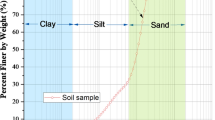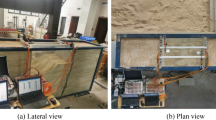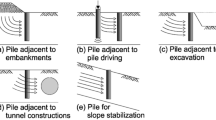Abstract
The failure to achieve minimum design overlap between secant piles compromises the ability of a structure to perform as designed, resulting in water leakage or even ground collapse. To establish a more realistic simulation and provide guidelines for designing a safe and cost-effective secant-pile wall, a three-dimensional model of a secant pile, considering the geometric imperfections of the diameter and direction of the borehole, is introduced. An ultrasonic cross-hole test was performed during the construction of secant piles in a launching shaft in Beijing, China. Based on the test results, the statistical characteristics of the pile diameters and orientation parameters were obtained. By taking the pile diameter D, inclination angle β, and azimuth angle α as random variables, Monte Carlo simulations were performed to discuss the influence of different design parameters on the probability density functions of the overlap of secant piles. The obtained results show that the randomness of the inclination angle and pile diameter can be well described by a normal distribution, whereas the azimuth angle is more consistent with a uniform distribution. The integrity of the secant-pile wall can be overestimated without considering the uncertainty of geometric imperfections. The failure of the secant-pile wall increases substantially with increasing spatial variability in drilling inclination and diameter. A design flowchart for pile spacing under the target safety level is proposed to help engineers design a safe and economical pile wall.
Similar content being viewed by others
Abbreviations
- D :
-
pile diameter
- H :
-
excavation depth
- H max :
-
limit excavation depth
- k :
-
hole diameter shrinkage factor
- L :
-
pile spacing
- P f :
-
failure probability
- δ :
-
initial overlap
- δ c :
-
overlap at certain depth
- δ lim :
-
limit overlap of adjacent piles
- α :
-
azimuth angle
- β :
-
inclination angle
References
Liao S M, Li W L, Fan Y Y, Sun X, Shi Z H. Model test on lateral loading performance of secant pile walls. Journal of Performance of Constructed Facilities, 2014, 28(2): 391–401
Anderson S A, Williams J L. Road stabilization, reconstruction, and maintenance with a combined mechanically stabilized earth and secant pile wall: Zion National Park, Utah. Transportation Research Record: Journal of the Transportation Research Board, 2002, 1808(1): 76–83
Finno R J, Bryson S, Calvello M. Performance of a stiff support system in soft clay. Journal of Geotechnical and Geoenvironmental Engineering, 2002, 128(8): 660–671
Wang A H. Drilling occlusive piles—New style of metro protecting structure. Journal of Railway Engineering Society, 2003, 77(1): 53–59 (in Chinese)
Chen B, Shi B, Lin M. A study on the scents pile in soft soil for Nanjing metro project. Chinese Journal of Geotechnical Engineering, 2005, 27(3): 354–357 (in Chinese)
Zhou X L, Liao S M, Song B. Settlement analysis of adjacent buildings induced by secant pile construction in soft ground. Chinese Journal of Geotechnical Engineering, 2006, 28(S0): 1806–1810 (in Chinese)
Anderson T C. Secant piles support access shafts for tunnel crossing in difficult geologic conditions. In: GeoSupport 2004: Drilled Shafts, Micropiling, Deep Mixing, Remedial Methods, and Specialty Foundation Systems. Orlando, FL: American Society of Civil Engineers (ASCE), 2004, 299–308
Bruce D A, di Cervia A R, Amos-Venti J. Seepage remediation by positive cut-off walls: A compendium and analysis of North American case histories. Boston, MA: ASDSO Dam Safety, 2004, 10–14
Simpson D E, Phipps M, di Cervia A L R. Constructing a cutoff wall in front of Walter F. George dam in 100 feet of water. Hydro Review, 2006, 25(1): 42, 44–16, 50–51
Ketchem A J, Wright G W. The Use of Secant Pile Walls in the Rehabilitation of the Pohick Creek Dam No. 2 (Lake Barton) Auxiliary Spillway. Kansas City, Missouri: American Society of Agricultural and Biological Engineers, 2013
Bryson L S, Zapata-Medina D G. Finite-element analysis of secant pile wall installation. Proceedings of the Institution of Civil Engineers-Geotechnical Engineering, 2010, 163(4): 209–219
Chehadeh A, Turan A, Abed F. Numerical investigation of spatial aspects of soil structure interaction for secant pile wall circular shafts. Computers and Geotechnics, 2015, 69: 452–461
Poulos H G. Pile behavior—Consequences of geological and construction imperfections. Journal of Geotechnical and Geoenvironmental Engineering, 2005, 131(5): 538–563
Amos P D, Bruce D A, Lucchi M, Watkins N, Wharmby N. Design and construction of deep secant pile seepage cut-off walls under the Arapuni dam in New Zealand. In: The 28th USSD Conference: The Sustainability of Experience—Investing in the Human Factor. Portland, OR: United States Society on Dams (USSD), 2008, 5–6
Wharmby N, Perry B, Waikato H. Development of Secant Pile Retaining Wall Construction in Urban New Zealand. Hamilton, Waikato: Brian Perry Civil, 2010
Liu Y, Lee F H, Quek S T, Chen E J, Yi J T. Effect of spatial variation of strength and modulus on the lateral compression response of cement-admixed clay slab. Geotechnique, 2015, 65(10): 851–865
Pan Y, Liu Y, Hu J, Sun M, Wang W. Probabilistic investigations on the watertightness of jet-grouted ground considering geometric imperfections in diameter and position. Canadian Geotechnical Journal, 2017, 54(10): 1447–1459
Pan Y, Liu Y, Chen E J. Probabilistic investigation on defective jet-grouted cut-off wall with random geometric imperfections. Geotechnique, 2019, 69(5): 420–433
Zhang L M, Wong E Y. Centrifuge modeling of large-diameter bored pile groups with defects. Journal of Geotechnical and Geoenvironmental Engineering, 2007, 133(9): 1091–1101
Nadeem M, Chakraborty T, Matsagar V. Nonlinear buckling analysis of slender piles with geometric imperfections. Journal of Geotechnical and Geoenvironmental Engineering, 2015, 141(1): 06014014
Croce P, Modoni G. Design of jet-grouting cut-offs. Proceedings of the Institution of Civil Engineers-Ground Improvement, 2007, 11(1): 11–19
Wang Y, Zhang G, Hu Q. Analysis of stability of bored pile holewall. Chinese Journal of Rock Mechanics and Engineering, 2011, 30(S1): 3281–3287 (in Chinese)
Huang S, Quek S T, Phoon K K. Convergence study of the truncated Karhunen-Loeve expansion for simulation of stochastic processes. International Journal for Numerical Methods in Engineering, 2001, 52(9): 1029–1043
British Standard. ICE Specification for Piling and Embedded Retaining Walls. London: Institution of Civil Engineers (Great Britain), ICE Publishing, 1996
Singapore Standard. Foundation Supervision Guide. Singapore: Association of Consulting Engineers & Institution of Engineers, 2012
China Standard. Technical Standard for Secant Piles in Row. Beijing: China Architecture & Building Press, 2018 (in Chinese)
Kempfert H G, Gebreselassie B. Excavations and Foundations in Soft Soils. Munich: Springer, 2006, 349–460
Fetzer C A. Performance of the concrete wall at wolf creek dam. In: Transactions of 16th International Commission on Large Dams. San Francisco, CA: International Commission on Large Dams (ICOLD), 1988, 277–282
Wang Q, Zhao C, Zhao C, Xue J X, Lou Y. Influence of normal and reverse mud circulations on hole diameter of cast-in-situ bored piles. Chinese Journal of Geotechnical Engineering, 2011, 33(S2): 205–208 (in Chinese)
Zhao C, Chen H, Zhao C, Xue J. Research on change law of hole diameter over time and space in drilling cast-in-place piles considering unloading effect. Rock and Soil Mechanics, 2015, 36(S1): 573–576 (in Chinese)
Pan Q, Dias D. Probabilistic analysis of a rock tunnel face using polynomial chaos expansion method. International Journal of Geomechanics, 2018, 18(4): 04018013
Hamdia K M, Rabczuk T. Key parameters for fracture toughness of particle/polymer nanocomposites: Sensitivity analysis via XFEM modeling approach. In: Fracture, Fatigue and Wear. Singapore: Springer, 2018, 41–51
BSI. BS EN 1997-2: 2007. Eurocode 7-Geotechnical Design, Part 2: Ground Investigation and Testing. London: BSI, 2007
Zhuang X, Zhou S, Sheng M, Li G. On the hydraulic fracturing in naturally-layered porous media using the phase field method. Engineering Geology, 2020, 266: 105306
Zhou S, Rabczuk T, Zhuang X. Phase field modeling of quasi-static and dynamic crack propagation: COMSOL implementation and case studies. Advances in Engineering Software, 2018, 122: 31–49
Zhou S, Zhuang X, Rabczuk T. Phase-field modeling of fluid-driven dynamic cracking in porous media. Computer Methods in Applied Mechanics and Engineering, 2019, 350: 169–198
Zhou S, Zhuang X, Rabczuk T. Phase field modeling of brittle compressive-shear fractures in rock-like materials: A new driving force and a hybrid formulation. Computer Methods in Applied Mechanics and Engineering, 2019, 355: 729–752
Zhou S, Zhuang X, Rabczuk T. A phase-field modeling approach of fracture propagation in poroelastic media. Engineering Geology, 2018, 240: 189–203
Zhou S, Zhuang X, Zhu H, Rabczuk T. Phase field modelling of crack propagation, branching and coalescence in rocks. Theoretical and Applied Fracture Mechanics, 2018, 96: 174–192
Acknowledgements
The authors would like to acknowledge the National Natural Science Foundation of China (Grant Nos. 51978040 and 51378054) and the National Basic Research Program of China (973 program, No. 2015CB057800) for supporting this research.
Author information
Authors and Affiliations
Corresponding author
Rights and permissions
About this article
Cite this article
Yang, Y., Jin, D., Li, X. et al. Probabilistic analysis of secant piles with random geometric imperfections. Front. Struct. Civ. Eng. 15, 682–695 (2021). https://doi.org/10.1007/s11709-021-0703-2
Received:
Accepted:
Published:
Issue Date:
DOI: https://doi.org/10.1007/s11709-021-0703-2




